Citizens' forums, and attitudes to agriculture, environment and rural priorities: research report
Results of an independent study into Scottish public attitudes to the environment, agriculture and rural development.
Financial Assistance to the sector
The research identified support for the reallocation of financial assistance to the agricultural sector, both in terms of the allocation of funding to farmers but also in terms of the funding split among the three key priority areas of the Common Agricultural Policy (farmers and food production, environment and rural communities).
To this end, a key guiding principle for the design of future policy should be ensuring that financial assistance to the sector was based on greatest need, and also ensuring a fairer distribution of support. There was a view that the current system of support to farmers which prioritises the potential productivity of land may gloss over the goals of equity, and other social responsibilities such as protecting the natural environment and supporting rural communities. Furthermore, in terms of the funding split within the Common Agricultural Policy, there is the view that the current policy which prioritises food production was designed to overcome issues of unstable food supplies, which no longer apply, thus paving the way for different thinking about how future funding is allocated within the policy.
While the research identifies that there is support for financial assistance to the sector, there is an underlying issue around the levels of spending reserved to agricultural policy. According to the Treasury's Public Expenditure Statistical Analyses, expenditure on agriculture and related functions in Scotland is 17.6%[25] of the UK total spend in this area, more than double Scotland's population share. The implications of this surround the fiscal arrangements with the rest of the UK - given that Scotland has proportionately more spending on agriculture and related functions, if the Barnett formula were applied to calculate future agricultural spending allocations to Scotland (which enables asymmetry in spending with England and adjusts the amount with the population share in other parts of the UK) Scotland would see the relative spending share decline from current levels.
Criteria for funding support to farmers
The survey identified support for different criteria for the allocation of support for farmers than are presently applied under the Common Agricultural Policy. 30% preferred support to farms to be based on maintaining a stable farming industry, and 24% preferred the budget to be based on farm size, with smaller farms and crofts receiving a greater share than at present. A relatively small proportion of the sample (7%) preferred the budget to be distributed based on farm size, with larger farms with better quality land receiving the highest payments, as is currently applied.
Figure 8.1. Priorities for funding allocation to farms
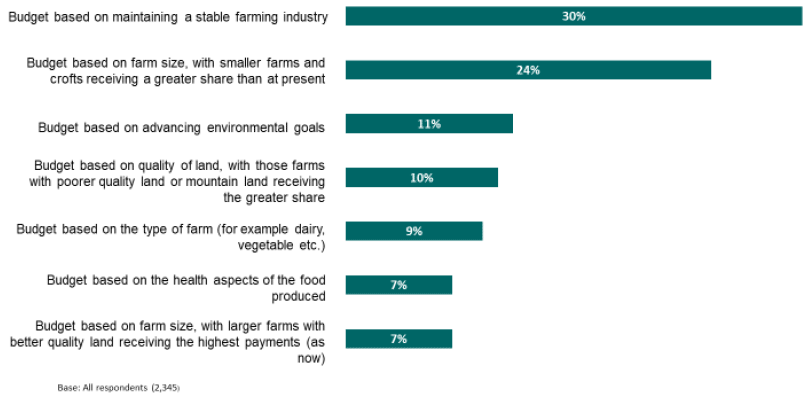
Those in remote rural and accessible rural locations were more likely than those in large urban areas to prefer funding to farms to be allocated based on the quality of land, with those farms with poorer quality land receiving the greatest share of funding (18% and 12% respectively compared with 7% among large urban areas). These results may in part be related to the higher prevalence of rough grazing or less favoured areas in these parts of Scotland.
There were also differences in the result by age: those aged 65+ were more likely than those under 35 to prefer funding for farms to be based on maintaining a stable farming industry (37% compared with 24%). Furthermore, those aged under 35 were almost twice as likely as those aged 65+ to prefer funding to be based on advancing environmental goals (15% compared with 8%).
The issue of the criteria for providing funding to farmers was further explored at the Citizens' Forums. The question posed to Forum participants was drawn from the national survey to enable comparative analysis with the national survey research findings and identify movement in attitudes post-deliberation.
In the national survey 30% of respondents had selected 'budget based on maintaining a stable farming industry' as their preferred option, making it the highest ranked option for funding allocations. There was some concern in the review of these results that this may simply have been the safe and/or easy option to choose, so for the Citizens' Forums this option was not included in order to dig deeper into the reasons people gave for either wanting change or maintaining the status quo.
This meant that the options presented to participants were as follows:
1. Allocation based on farm size, with smaller farms and crofts receiving a greater share than at present
2. Allocation based on activity taken to advance environmental goals
3. Allocation based on quality of land, with those farms with poor quality of land or mountain land receiving the greater share
4. Allocation based on the type of farm (for example dairy, vegetable, etc.) and related demand in Scotland
5. Allocation based on the health aspects of the food produced
6. Allocation based on farm size, with larger farms with better quality land receiving the highest payments (as now)
While some of the participants were critical that there was not an option to advocate for no funding to be given to subsidise farms, most participants agreed that the sector is currently so reliant on this type of support that farmers would struggle to maintain a viable business if funding was suddenly withdrawn. Removing any future equivalent of the types of support farmers received via CAP was therefore seen as something that could cripple the sector in the short term. Furthermore, participants tended to agree that this would remain the case unless there were significant changes made to the price's farmers receive for their produce and the attitude of the public (and the export market) as to what are seen as acceptable food prices.
Preferred Criteria
After spending time evaluating each of the criteria in turn within their discussion groups participants in the Citizens' Forums completed a private ballot, indicating their top three preferences for funding support to farmers.
Figure 8.2: 1st preference votes from member of the Citizens' Forum on their preferred criteria for support to farmers
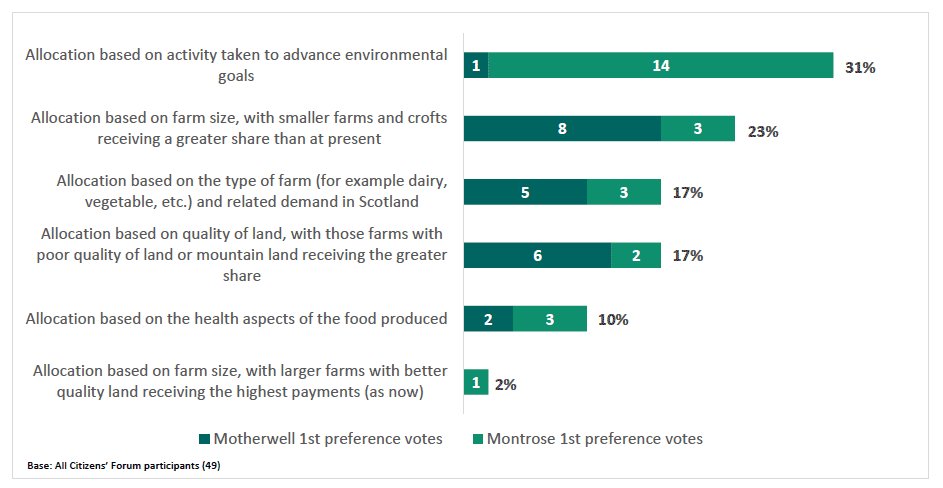
Overall, funding allocations based on advancing environmental goals was the most highly ranked criterion for future support to farmers. It should be noted that this outcome is largely driven by the high proportion of participants in the Montrose Citizens' Forum selecting this criterion as their first option. Only one participant in the Motherwell Citizens' Forum identified this as their preferred option, highlighting the different emphasis given to environmental issues in these discussions.
Key reasons for prioritising this criterion for funding were that it integrates food production with environmental concerns, "looks after the quality of the environment" and "increases knowledge of environmental goals". There were however some concerns expressed that this option could favour bigger landowners who had more options for what to do on their land to mitigate their environmental impacts and therefore "may put smaller lands at a disadvantage". Some participants also felt that a policy based on this criteria would discriminate against certain types of farms, e.g. cattle farming, where it is intrinsically harder to minimise the environmental impacts of their farming activities.
Allocations based on farm size 'with smaller farms and crofts receiving a greater share than at present' was the most consistent preference from participants in the Motherwell Citizens' Forum.
Many of the arguments in favour of this approach focused on the need to maintain a place within the sector for small, independent farms and crofts as "just now they are struggling, and we are losing smaller farms / crofts creating more unemployment and poverty". It was also noted that "bigger farms have more opportunity for diversification (and to do things differently), camping, more variety of crops and livestock, farm shops, petting zoos, farm stays etc." as a reason why there should be more support for smaller landholdings. Related comments included "small farms are important (not want to be like banks and focus on the big ones only)" and that the current allocation policy reflected the "same old story, we don't look after the wee man."
For those who prioritised the type of farm, and its relevance to food demands in Scotland, as their preferred criterion the main reasons were that then production "would be needs driven" and have the flexibility to respond to "changing consumer need". For some this was a vital focus because the foods that are part of our staple diet would be those receiving the subsidies (if needed) and as a result of this, "self-sufficiency should follow - if it is managed correctly based on product demand".
Concerns, however, were also raised that this model could be "counter indicative" to some of the wider priorities expressed as "bigger farms may focus on staple outputs" and as such create "less diversity as more profitable farms are preferred". Participants also noted the risk of "overproduction if quotas are not set" and recognised that, given the low proportion of quality arable land in Scotland, that there were practical limitations on how the land could be used by farmers for different types of "in-demand products".
Allocation of funding based on land quality, with those farms with poorer quality land receiving the greatest support (i.e. the opposite of the current situation) was prioritised by 17% of participants. This was largely on the basis that it seemed a fairer allocation of funding towards those farmers who would struggle most to make their land profitable: "Scotland has poorer land and should get a greater allocation of the subsidy". Arguments in favour of this criterion also recognised that famers working poorer quality land, particularly in highland and island communities, may also serve other wider socio-economic functions, for example as anchor employers within rural areas and that subsidy therefore could have wider, positive knock-on impacts. This is consistent with the higher levels of support for this option found in the national survey among those residing in rural locations.
There was, however, also a counter argument presented that suggested land quality itself was not enough to demonstrate entitlement. Rather, in this case, it was argued that a demonstrable commitment to maximising the value of land was required before any further entitlements were offered: "farmers on poor quality land should not get greater support unless they can show that they are undertaking activities to diversify the productivity of their land."
Finally, the current system of funding which rewarded the size and quality of the land farmers held, was generally not supported by participants in the Citizens' Forums, receiving only 1 first preference vote. This was largely based on the sense that this model of funding supported those who "should be able to help themselves", although there was also a sense of security in retaining a tried-and-tested model: "better the devil you know".
When preferential votes were considered there was little change in the overall ranking of the options, although the weight of opinion balanced out between the first and second preference, as can be seen in the graph below. Support for the current system of funding allocation however remained low, suggesting that participants were generally interested in seeing change, despite the lack of consensus regarding what that change should be.
Figure 8.3: Preferential votes on preferred criteria for support for the farming sector
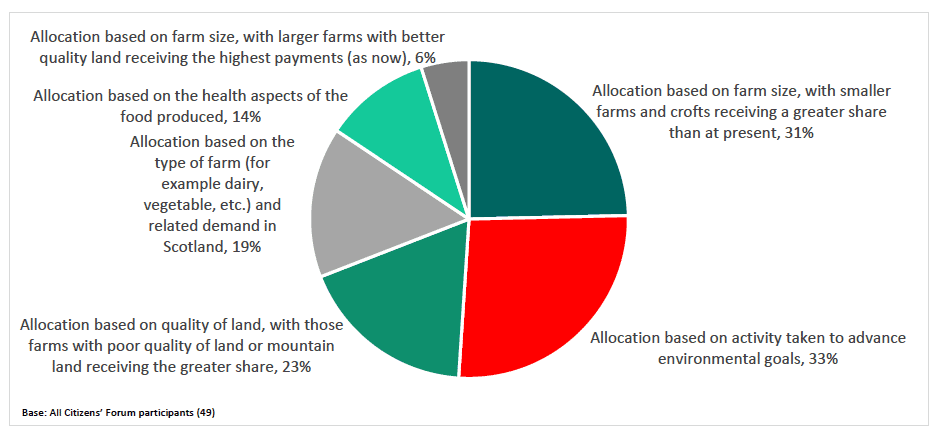
Finally, the table below demonstrates the impact that the deliberative process, i.e. two days of learning and considering the issues, had on the participants' final preferences.
Table 8.1: Comparative look at how first preferences for how the balance of funding should be distributed between CAP priorities[26]
| Allocation based on farm size (as now) | Allocation based on farm size, with smaller farms receiving a greater share | Allocation based on activity taken to advance environmental goals | Allocation based on quality of land, with poorer quality of land prioritised | Allocation based on the type of farm produce - related demand in Scotland | Allocation based on the health aspects of the food being produced | |
|---|---|---|---|---|---|---|
| Survey | 6% | 26% | 10% | 9% | 8% | 8% |
| Pre-deliberation | 8% | 37% | 22% | 8% | 10% | 14% |
| Post-deliberation | 2% | 23% | 31% | 17% | 17% | 10% |
Here it can be seen that, following the deliberative process, providing support for those able to demonstrate environmental improvements grew notably. Further there was a doubling in support given to providing funding to farmers with lower quality land in order to help sustain the diversity of the sector and, by default, support rural communities.
Preferences for funding split within the CAP
Unlike the current policy formulation of the Common Agricultural Policy, a quarter (26%) of survey respondents prefer all three areas of the policy (farmers and food production, environment and rural communities) to receive the same amount of the policy budget.
17% prefer a greater share of the policy budget being spent on supporting rural communities and protecting the natural environment; and a smaller proportion (15%) prefer to retain spending as it currently is with the vast proportion of the budget being spent on farmers and food production.
Figure 8.4. Preferences for funding allocations within the CAP
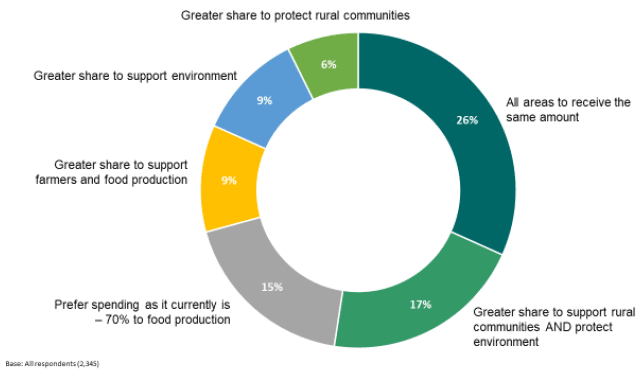
There were a number of key variations in the results:
- Urbanity and rurality is the most significant predictor of views on the allocation of spending for the CAP budget. Those residing in accessible rural locations were more likely than those in large urban areas and other urban areas to prefer to retain spending as it currently is, with the vast majority of the policy budget allocated to farming and food production (21% compared with 14% and 15% respectively).
- Women were more likely than men to prefer all three areas of the policy to receive the same amount (30% compared with 23%). By comparison, men were more likely than women to prefer a greater share of the budget going to support farmers and food production than present (12% compared with 9%).
- Those aged 35 and under were more likely than all other age categories to prefer a greater share of support to be allocated to support the natural environment (14% among under 35's compared with 7% among 35-44; 8% among 45-54; 8% among 55-64; and 6% among 65+).
The question of how the future balance of funding allocations might be differently apportioned between the three broad CAP priority areas, was explored further at the Citizens' Forums. The framing of the question posed to Forum participants was consistent with the national survey to enable comparison of the results.
When participants were asked to vote individually on these options following their discussion there was an overall consistency on how the votes were distributed between the two Citizens' Forum locations (Motherwell/Montrose). The graph below shows the distribution of 1st preference votes across the two Citizens' Forums.
Figure 8.4: 1st preference votes from member of the Citizens' Forum on their preferred balance of funding allocations to farming and food production, environmental management and supporting rural communities - post deliberation.
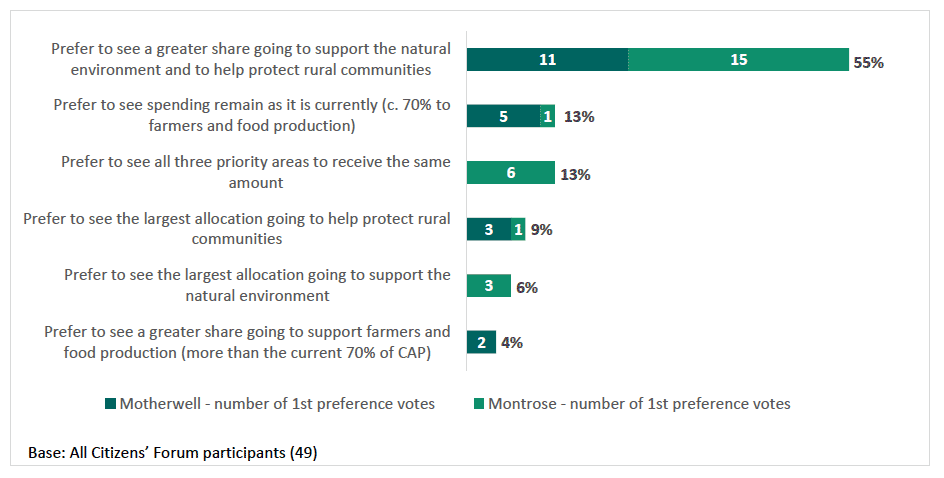
Overall, more than half (55%) of the first preference votes went to seeing a greater share of funding going to 'support the natural environment and to help protect rural communities. During discussions, participants pointed out that a greater proportion of support given to rural communities more broadly "would encourage tourism", help "diversify business" and support "other business development" in rural communities. It was also seen as a way to "repopulate/sustain countryside population."
Caution to this preference included a possible "negative perception by other communities (e.g. urban/fishing industries)" and that, given what they had learnt about the important role that subsidies have played in maintaining an active farming sector in Scotland, it "should not be at a disadvantage for farmers."
Following on, 13% of first preference votes went to seeing 'all three priority areas to receive the same amount of funding'. This was noticeably only voted for by participants in Montrose. This may, in part, be because these participants, by the very nature of living in a much more rural environment, have a greater innate understanding of the interplay between the agricultural sector and the other economic and business demands of rural communities. This option was described as being a 'fair' way to balance out the competing needs of the farming sector, the environment and rural communities more broadly.
Participants across both of the groups however identified impacts and reasons both in favour and against this policy. While some participants stated that maybe this would result in a "wishy-washy" compromised policy, others argued that "the same amount is fairer (no preferential treatment)." One of the key objections was that, while there was no question this balance of funding would be good for sustaining rural communities, there are "other ways to support rural communities" (including that they "should get funding from local authorities") and that the funding currently distributed through CAP should focus specifically on agricultural lands. Comments relating to this emphasis on farming and food production emphasised that "food has to be a priority" and that there is a "risk to farming if the overall budget [available to them] becomes too small".
Seeing 'spending remain as it is currently (70% to farmers and food production)' received 13% of the first preference votes overall. This also seems to reflect the growing recognition participants had gained throughout the weekend of the role subsidies have played in supporting Scottish farming and the potential impacts on the agricultural sector if this was removed. Comments from participants on these options tended to argue that, while keeping the current system may seem "unfair" and "not fit for purpose", it would provide "stability" and is "needed to keep high standards." While 13% did support this option, this was mainly selected by participants in Motherwell, which suggests that there is a preference for the status quo where there is less experiential knowledge of the interdependence of rural, economic and environmental issues.
Only 4% overall supported the idea of increasing the proportion of funding directly allocated to farming and food production. When talking about this, participants tended to focus on the ability of funding to lead to "more jobs in farming", "cheaper food," more "variety of food," and "could increase quality standards." Participants also felt that it could help with "diversification of the land use" or "help make the land more profitable" for example through "an emphasis on local produce for local people or for high quality export markets".
On the other hand, opponents to these models expressed the view that such continued spending "could emphasise/enable sub optimal production patterns" and "rewards people just for having land, not for what they do with it." One table in Montrose disagreed with the idea of increasing the percentage of CAP funding available for farmers and food production, saying it was simply "not up for discussion" as the industry was already far too reliant on public money and needed to either develop sustainable business models or cease to operate.
In particular, there was discussion in Montrose about the New Zealand model in which farming subsidies have been phased out since 1984. While the model has seen increased levels of productivity, and growth in other parts of the economy through the reallocation of support, there has been population decline and loss of service provision in rural communities which has historically been reliant on the farming sector[27] . Therefore, any changes to the agricultural sector should be offset with a redirection of support to rural communities.
Only 6% of participants' first preference went to seeing 'the largest allocation going to support the natural environment.' While there had been an almost universal interest in reducing the environmental impacts of the farming sector the majority of participants seem to have balanced this demand, when it came to the proportional allocation of funding, with an acknowledgement that food production was at the heart of farming and without an emphasis on supporting this other priorities became less relevant. In the discussions participants therefore tended to acknowledge that, while a significant increase in funding for environmental protections would "be great for the natural environment" and that it is an area that "needs more investment", too much emphasis placed here would mean that overall "farmers would struggle", it could "kill off farming" and that "no focus on food production is a negative."
The table below demonstrates the impact that the deliberative process had on the participants' final preferences. At the beginning of the process their initial response to the question about the balance of funding was predominantly consistent with the national survey results. However, there was a higher preference for a greater share to be spent on supporting the natural environment and protecting rural communities, comparative to the national survey results. This difference was particularly driven by the higher priority attributed to these two aspects of policy among participants in Montrose.
However, post-deliberation the results significantly changed. 55% recorded that their first preference was to see 'a greater share going to support the natural environment and to help protect rural communities' (for the reasons given above). It is also worth noting that support for an equal distribution of funding between the three areas, the top priority identified in the national survey, had dropped by half (although initially given significant support). The option of the balance of a greater share being given to support farming and food production was also broadly rejected by participants, with only 2 people giving it their vote in the final ballot.
Table 8.3: First preferences for how the balance of funding should be distributed between CAP priorities
| Prefer all three priority areas to receive the same amount | A greater share going to support the natural environment and to help protect rural communities | Prefer spending to remain as it is currently | A greater share going to support farmers and food production | The largest allocation going to support the natural environment | The largest allocation going to help protect rural communities | |
|---|---|---|---|---|---|---|
| Survey | 26% | 17% | 15% | 9% | 9% | 6% |
| Pre-deliberation | 31% | 31% | 16% | 12% | 6% | 4% |
| Post-deliberation | 13% | 55% | 13% | 4% | 6% | 9% |
The finding that post-deliberation, just over half (55%) preferred a greater share of support to be allocated to the natural environment and rural communities is aligned with the view that future policy should not simply focus on agriculture, but be a wider ecosystem services policy which supports the environment and rural communities. Ian Hodge, Professor of Rural Economy at the University of Cambridge, argues that
"We do not really need an agricultural policy; we need an ecosystem services policy. We need to set out thinking that our aim should be to deliver the maximum social value from rural land rather than to recreate an agricultural policy" [28] .
This suggests that a potential option would be to shift away from the current focus on agriculture and take a holistic view of the totality of ecosystem services encapsulating services that protect the natural environment, biodiversity, soil, landscape, cultural heritage, and provide food, sustainable energy, and water.
Points of consideration:
- Results on the financial assistance to the agricultural sector most strongly indicate a change in views by virtue of the deliberative process;
- Considering both the national survey and the outcome of the deliberative process there is support for the reallocation of financial support to the agricultural sector than is currently applied under the Common Agricultural Policy, covering the three main priority areas of the policy - agriculture, environment and rural development. The post-deliberation results show that over half (55%) prefer a greater share of support to be given to the natural environment and to support rural communities.
- There is support for funding to farmers to be based on advancing environmental goals, and supporting smaller farms;
- However, the issue of support criteria being based on land quality with poorer quality land being prioritised was also cited, particularly among those residing in rural communities as there was a recognition of the wider socio-economic functions of farmers working on poorer quality land e.g. as anchor employers within rural areas. The findings suggest that there is some support for some assistance to be reserved to farmers working on poorer quality land;
- In terms of funding allocations within the CAP, there was a clear preference (55%) for a greater allocation of support to the natural environment and rural communities; however, this was under the proviso that there would remain a focus on food production to avoid watering down the policy, recognising that there are other sources of support for rural communities and the environment.
Contact
There is a problem
Thanks for your feedback